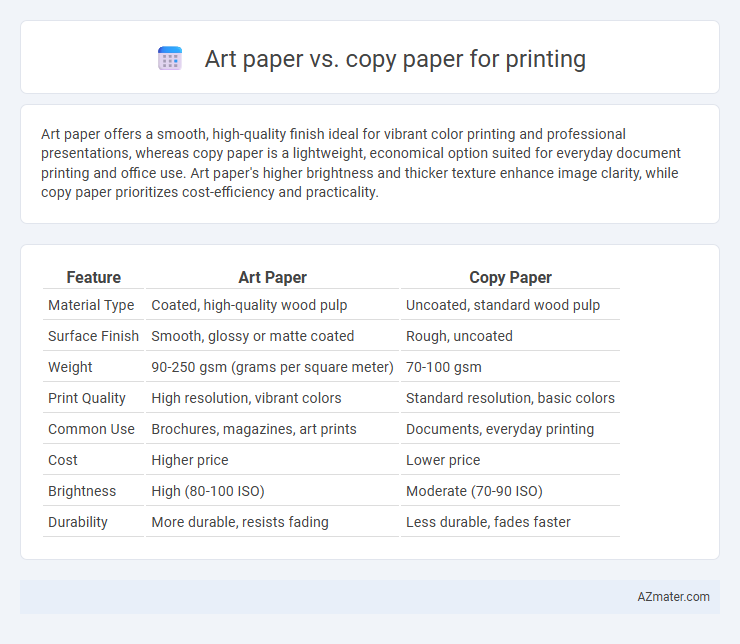Art paper offers a smooth, high-quality finish ideal for vibrant color printing and professional presentations, whereas copy paper is a lightweight, economical option suited for everyday document printing and office use. Art paper's higher brightness and thicker texture enhance image clarity, while copy paper prioritizes cost-efficiency and practicality.
Table of Comparison
| Feature | Art Paper | Copy Paper |
|---|---|---|
| Material Type | Coated, high-quality wood pulp | Uncoated, standard wood pulp |
| Surface Finish | Smooth, glossy or matte coated | Rough, uncoated |
| Weight | 90-250 gsm (grams per square meter) | 70-100 gsm |
| Print Quality | High resolution, vibrant colors | Standard resolution, basic colors |
| Common Use | Brochures, magazines, art prints | Documents, everyday printing |
| Cost | Higher price | Lower price |
| Brightness | High (80-100 ISO) | Moderate (70-90 ISO) |
| Durability | More durable, resists fading | Less durable, fades faster |
Understanding Art Paper and Copy Paper
Art paper is a high-quality, coated paper designed for vibrant color reproduction and sharp image clarity, making it ideal for professional photo printing, brochures, and marketing materials. It features a smooth or glossy finish that enhances ink absorption and provides a visually appealing texture, distinguishing it from standard papers. Copy paper, by contrast, is an uncoated, lightweight, and economical option primarily used for everyday printing and document copying, offering basic print quality suited for text rather than high-resolution images.
Key Differences Between Art Paper and Copy Paper
Art paper features a coated surface that enhances image sharpness and color vibrancy, making it ideal for high-quality photo printing and professional marketing materials. Copy paper has a smoother, uncoated texture designed for everyday printing tasks, offering affordability and compatibility with most office printers. The primary differences lie in coating, brightness levels, and weight, with art paper generally being heavier and brighter to support detailed, vivid prints compared to the lighter, plain finish of copy paper.
Texture and Finish Comparison
Art paper offers a smooth, glossy or matte finish that enhances image vibrancy and sharpness, making it ideal for high-quality prints and photographs. Copy paper features a more porous, matte texture designed for everyday printing with standard ink absorption, which results in less vivid colors and detail. The choice between art paper and copy paper significantly affects the tactile feel and visual impact of printed materials, with art paper delivering a more professional and polished appearance.
Color Reproduction Capabilities
Art paper offers superior color reproduction capabilities compared to copy paper due to its smooth, coated surface that enhances ink absorption and vibrancy, making images appear more vivid and detailed. Copy paper, designed primarily for text printing, has a porous texture that absorbs ink unevenly, leading to duller colors and less precise image quality. For high-quality color prints, art paper is the preferred choice as it maintains sharpness and color accuracy critical for professional presentations and photographic prints.
Print Quality and Sharpness
Art paper offers superior print quality and sharpness due to its coated surface that enhances ink absorption and color vibrancy, making images and text appear more vivid and crisp. Copy paper, being uncoated and designed for everyday printing, has a more porous texture that can cause ink to spread slightly, resulting in less sharpness and muted colors. For professional prints requiring high detail and color accuracy, art paper is the optimal choice, whereas copy paper suits standard document printing.
Ink Absorption and Drying Time
Art paper features a coated surface that limits ink absorption, resulting in sharper images and vibrant colors ideal for high-quality photo and graphic prints. Copy paper, typically uncoated, absorbs ink more readily, which can cause slight bleeding and longer drying times, affecting print clarity. The fast drying time of copy paper suits everyday document printing, while art paper's slower drying time enhances print detail and color depth.
Suitability for Different Printing Projects
Art paper offers a smooth, high-quality surface ideal for printing vibrant images and detailed graphics, making it perfect for photo prints, brochures, and marketing materials that require a professional finish. Copy paper is designed for everyday use, delivering decent print clarity and reliability suited for documents, drafts, and bulk printing with inkjet or laser printers. Selecting art paper enhances visual appeal in creative projects, while copy paper supports efficient, cost-effective printing for routine office tasks.
Cost Considerations: Art Paper vs Copy Paper
Art paper generally costs significantly more than copy paper due to its higher quality, specialized coatings, and better weight, making it ideal for premium prints but less budget-friendly for high-volume use. Copy paper is much more affordable and suitable for everyday printing needs, with lower production costs and simpler manufacturing processes. Choosing between art paper and copy paper should consider the balance between print quality requirements and budget constraints, especially for large-scale print jobs.
Environmental Impact and Sustainability
Art paper, often coated and heavier, typically requires more energy and chemical processing, leading to a higher environmental impact compared to copy paper, which is usually uncoated and produced with fewer resources. Copy paper tends to have a smaller carbon footprint, especially when made from recycled fibers or certified by sustainable forestry programs like FSC or PEFC. Choosing recycled or sustainably sourced copy paper helps reduce deforestation, water usage, and greenhouse gas emissions, making it a more eco-friendly option for printing needs.
Choosing the Right Paper for Your Printing Needs
Art paper offers a smooth, high-quality finish ideal for vibrant color printing, detailed images, and professional presentations, making it suitable for brochures, flyers, and art reproductions. Copy paper provides a cost-effective option with a standard weight and texture, perfect for everyday document printing and internal office use. Selecting the right paper depends on the desired print quality, project purpose, and budget constraints to achieve optimal results.

Infographic: Art paper vs Copy paper for Printing
 azmater.com
azmater.com